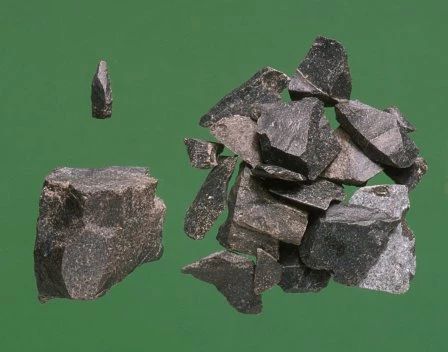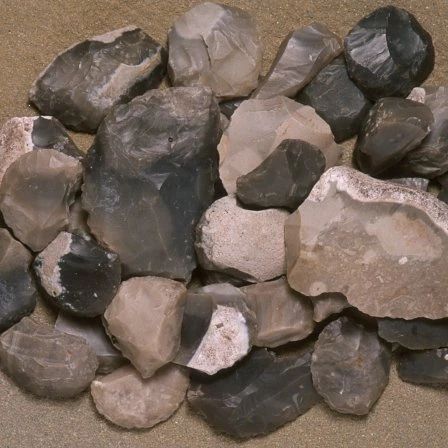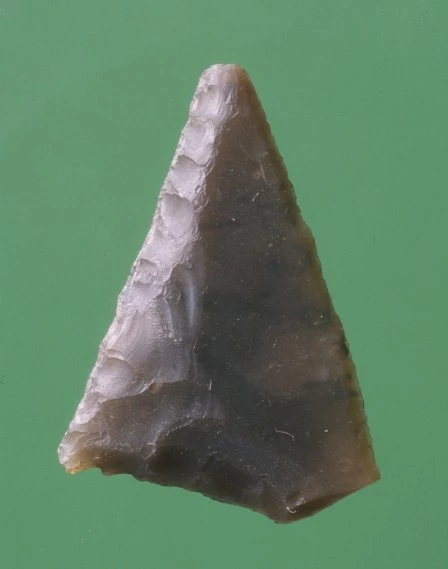The Flint Finder of Wales
Phil Shepherd at National Museum Cardiff with some of the finds he has collected over the past 25 years.
A small group of later Mesolithic flints from Cefn Rhos-Gwair (Rhondda Cynon Taff), dating from 7500-4000BC.
Group of flint scrapers from Carn-y-Bwlch (Rhondda Cynon Taff).
Arrowhead from Lluest Wen (Rhondda Cynon Taff), dating to the later Neolithic (3400-2500BC).
The donation of over one and a half thousand small stone relics, collected over 25 years, to the collections of Amgueddfa Cymru, has helped improve our understanding prehistoric life in South Wales.
For over 25 years, forestry worker Phil Shepherd has searched for prehistoric flint tools as part of his work preparing areas of land for tree-planting or felling for Natural Resources Wales.
In this time, Phil discovered 1,636 individual pieces of flint, all of which he has brought to Amgueddfa Cymru and donated on behalf of Natural Resources Wales.
Flint tools
Flint is a stone that can be shaped into sharp blades. These razor-sharp blades were used commonly by early man in Wales for hunting deer and spearing fish, as well as for cutting tools.
Many of the flints Phil has found in the forest range in date from the early Mesolithic (beginning 9200BC) through into the Bronze Age (about 2000BC). The number of known Mesolithic sites in the uplands of south Wales has increased considerably through his many discoveries.
Cefn Rhos-Gwair flints
A small group of later Mesolithic flints from Cefn Rhos-Gwair (Rhondda Cynon Taff), dating from 7500-4000BC. The largest piece shown measures about 2.5cm (1 inch) in length.
These flints were left behind by a hunter who had been making a spear. They include small blades (right), a block of stone known as a core (bottom left) from which the blades would have been removed, and a single microlith (or barb) from a spear (top left).
Carn-y-Bwlch flints
Each piece is about 2.5cm (1 inch) long. This important collection of Early Bronze Age flint scrapers (dating to sometime after 2500BC) were all found by Phil Shepherd.
Unexpectedly, the group also contained a comparatively recent gun flint which must have been inadvertently dropped near the Early Bronze Age collection.
Lluest Wen arrowhead
The arrowhead is 3cm (1.2 inches) long. The majority of the flints that Phil has found are made on small pebbles deposited by the melting of Ice Age glaciers.
However some, like this example, are made on a much finer quality black chalk flint that was clearly carried into the area from Wiltshire, the closest natural outcrop of flint to Wales.
Mesolithic Wales
In Mesolithic times the climate was warmer and damper and much of the landscape was heavily wooded with oak, elm, birch and hazel trees. There would have been few of the conifers that we now associate with today's Welsh forests.
It was only towards the end of the Stone Age period (about 4000BC) that people cleared the forests to make way for early agriculture. Many upland areas have been bare ever since, and hence evidence of ancient life has been left relatively undisturbed - until the more recent deliberate creation of forestry plantations.
Discoveries like those made by Phil and his colleagues from the Forestry Commission can provide important information about the lives once lived in a particular area of the country, with each piece telling a story, like the ones provided as captions to this article's images.
Background Reading
Prehistoric Wales by F. Lynch, S. Aldhouse-Green and J. L. Davies. Published by Sutton (2000).
Treasure by R. Hobbs. Published by The British Museum Press (2003).




Comments - (3)
Hi Sara,
Thanks very much for your reply.I followed the link and watched the video.The flint knapping looked fiendishly difficult, and I wondered whether bronze age students went to flint-knapping college.
Probably not.
I should explain that I was born and brought up in the Ogmore Valley and that my interest in its prehistory started when I joined the online Ogmore Valley Local History Facebook Group last year.
I noticed that members of the group had a great deal of interest in, and knowledge of, life in the valley since coal mining took hold in the nineteenth century.
When it came to pre-industrial history, however, there were just vague references to post-medieval farming communities.
Nothing seems to be known about the valley in the dark ages or, for all I know, as an outpost of the Roman Empire.
That being the case, I'd like to be able to write an article about the valley's early history and to upload it to the local history group, to which end I've decided to leapfrog over a few thousand years in order to end up in the Bronze Age; because I know, from burial mounds and cairns on the hilltops above the valley, that its prehistory goes back at least that far.
In view of the article on Phil Shepherd,there is no reason, as far as I can see, why there should not be flint tools or the detritus of flint knapping awaiting discovery in the Ogmore Valley hills or at lower levels.
At the moment, however, I have no idea where or how to start looking; but I'm working on it.Thanks again; bye for now.
Hi Laurence,
Thanks for comment.
I have passed on your enquiry to one of our archaeologists, and will post their response when I get it - they may choose to contact you by email in due course.
The prehistory of South Wales is fascinating - it's amazing to think of the time and skill that went into these beautiful pieces, all those years ago. I have really enjoyed learning about flink knapping from Dr Bruce Bradley, who is an expert in the craft, as well as an archaeologist - you might be interested in this video of him at work: Dr Bruce Bradley Flint Knapping Video